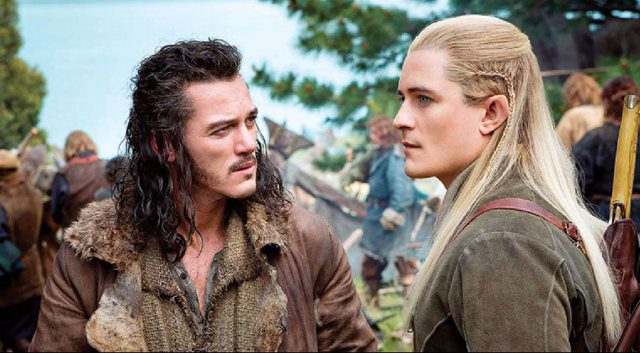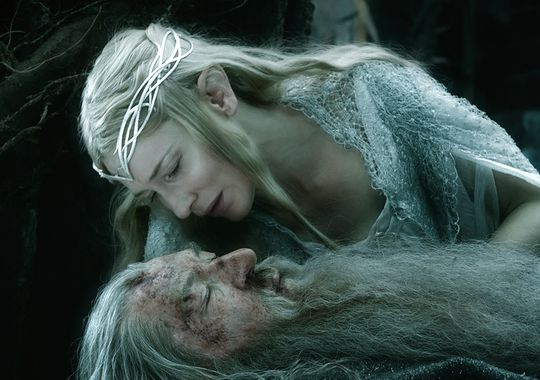As I approached the theatre to watch The Hobbit: The Battle of the Five Armies, I couldn’t help but remember the words of the most diehard fan of Lord of the Rings (that I know personally) when I asked them if they were excited for this third and final Hobbit: “Why did this have to be three films?” Though I certainly know other diehard fans, well steeped in LOTR lore, who are forever famished and hungry for anything Tolkien on the screen, this dude does not abide to the stretching out of a very short piece of literature to three overlong films that can’t stand on their own. I should probably clarify that I am not among this rabble of fans who can name every character, and recite the history of Middle Earth and the mythological inventions of the author. That review will be up shortly from GAMbIT cohort Trevor Dawson (Ed. Note: Find it here). No matter which way you cut it, there is little to justify this poorly-disguised scavenger hunt through movie-viewers’ wallets. Not to mention the strange fashion by which climactic events are parsed between the films haphazardly, and characters are invented to pad out the already excessive running time.
The film begins with a perfect case-in-point: The actual desolation of Smaug. I am clearly not the only one who found it beyond irritating that the 2nd film, whose very title was The Desolation of Smaug, did not actually end with this desolation. I also found it bewildering that the third film starts with the culminating event that should have ended that second film. So the climax of the previous film was carried over like a sad remainder to completely upend any semblance of a story arc in the third film. I know Peter Jackson was all gung-ho about ending Smaug on a cliffhanger, but this doesn’t make any sense. How much suspense can you wring out of a foregone conclusion? We all know what happens to Smaug, and it just makes everyone appear fruitlessly stupid to pretend that there’s any cliff left in this story to hang off of. The title tells us what happens, and anyone who ever read the book, or saw the animated film version of this book (the one that is infinitely more satisfying) knows what happens. We know because it’s the only really interesting thing anyone was looking forward to. And it didn’t happen in the film whose title promised it. So really this is just Peter Jackson and Co. laying bare their lucrative ambitions rather than their artistic ones. Sure the diehard fans who just can’t get enough are pleased to have more to feed from, but the film feels more plainly like an exercise that aims to make lemmings of us all.
This is the problem with the whole Hobbit series. Like many of the Harry Potter movies, little is done to really interpret the text, so all we have is an illustrated audiobook instead of a film. Where the book may have expanded the mythology and lore of Middle Earth and its inhabitants for readers of LOTR, so little of this prequel world onscreen is expanded intellectually or thematically that I can’t imagine what the artistic aim was in making three films. True, this film offers perhaps the most breathtaking images of any of The Hobbit movies. The movie often surprises us with bold, avant garde flourishes and sequences that spring up and surprise us from the pedestrian doldrums of the predictable direction. Thorin Oakenshield’s hallucinatory revelation in the golden hall that enables him to overcome the “dragon sickness,” (an expression I just can’t take seriously) turned what could have been another dull moment into a scene that had me fully entranced. Thorin sinking into the swirling, glowing golden floor was also one of the few times that the 3D added something to the experience other than inflated cost on both sides of the screen. Another of these naturally involved the great Cate Blanchett, who does not disappoint in her one scene. We get the fearsome strength and dark power within Galadriel (that we saw a flash of in Fellowship of the Ring) in full force here and it’s a thrilling little spectacle to behold. It’s one of the few times I felt the film provided something of a character that makes what we’ve already seen even more interesting.
Sadly, this is not the modus operandi of the film, or Hobbit series as a whole. The feeling of knowing what’s going to happen creeps in repeatedly, even if you don’t remember every detail of the book. Everything is clearly indicated for us so no one has to think or feel on their own, when the story should absorb you, not hold your hand. The humor is so canned that only superfans could find it funny- and even they had to force themselves to laugh at the screening I was at. Notice that you rarely hear any genuine laughter in the theatre during these “funny” moments in the LOTR and Hobbit films. Also, putting Gandalf in danger has no effect anymore, no matter how much you amp up the sturm und drang sections of the score we all know too well. Clearly he survives this, since he’s in the books and movies that follow from this point in fictional time, so my heart never raced and the adrenaline never flowed. This is the effect of the film not inspiring interest in the proceedings. We should be excited to see the journey play out onscreen, but instead no characters inspire any emotions, and the only one who does is the one that doesn’t exist in the book (Evangeline Lilly’s Tauriel). The prevalent theme, that if we all just valued the truest riches life had to offer instead of gold the world would be a better place, comes off as cynical from the producers of a movie that exists to make money more than tell a story, but exploits the respectability of the source material to market itself.
The title of this film refers to the fight for what Thorin’s small army of dwarves (and Bilbo-in-tow) have barricaded themselves inside Erabor: the old castle in the Lonely Mountain of the dwarves, filled with gold, that the vanquished Smaug had taken over. Everyone wants these misty mountain hops for the same reason everyone wants great real estate: location, location, location. It’s ideal for any group who wants to rule the land because of it’s vantage and security and of course all that gold inside. The five armies fighting for it are: the small group in the castle, the Elves, the Dwarves, the Orcs, and the survivors of Smaug’s last act of destruction. The battle lasts forever, for what feels like half of the film, and we still have to endure the boredom of the Orcs and their monosyllabic leader, who does little more than walk back and forth at the top of a mountain barking out instructions as detailed as those you’d find on a vintage Mortal Kombat game. Until his big fight. Then there’s another big fight and another – it’s all fighting. What should have been the final scene of one film is now an entire film of it’s own. Everyone is mad at someone else for not honoring their word, or not showing honor period. Yet the film deadens the complicated moral landscape with characters like the creepy little sycophant who kisses up to whoever is in charge but then disappears when danger is afoot. His weaselly selfishness is a useful survival tool until it isn’t. He’s one of those characters whose ugliness inside is reflected outside and nothing about him is surprising except for the dated conception of character. He’s weak and effeminate, the classic homophobic Hollywood stereotype that culminates in him cross-dressing to escape with the women and children rather than fighting in the battle. For as far as we’ve come, I felt like the movie was made 30 years ago.
Speaking of this flash of cinematic time-fuckery, it’s a strange place to be as a viewer watching a prequel that uses the same music cues and dramatic flourishes that we have learned, from the films of the succeeding story, to read as plainly labeled signposts for “happy” or “tragic” or “dangerous” or “funny.” What we learned from the film versions of the future events in this cycle, help us now to notice when the craft is manipulating us in this movie series. This does shockingly have some origin story cache expressed by the truest sense of déjà vu: a fateful commingling of what is foretold and what is molded by the characters’ actions, writ in the audience perception molded by a past vision of the future of this story. We, like the characters, choose what to make of our experience, only our choice doesn’t offer the morally tempestuous highs and lows that Tolkien does. The path of least resistance is to succumb to the marketing and the comfort of the formulaic construction (which has gone unchanged across 6 FILMS at this point!). Or we can be grinchy and rain on the hobbitses parade by pointing out the folly of defending tripe just because it feels good to be catered to. I’m feeling grinchy.
1.5 stars


